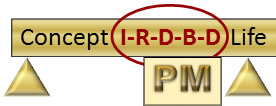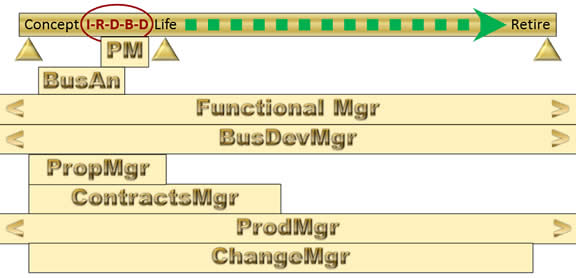Playing Nice With Others: Project managers operate in many different contexts, ranging from operational companies with few projects, to project oriented enterprises. Competent and performing project managers not only respect and serve our context, but also manage to get the context–including the permanent organization, to work for us.
One secret to accomplishing that feat–for the permanent organization to work for us—is to look at our efforts and relationships from Executives’ and Managers’ point of view, instead of just a project view. In this article, we will explore facets of those and other views.
The Executive View
Executives view projects and programs as part of their portfolio. Perhaps just a minor part, in some cases; major in others. And from an Executive viewpoint, there are many different disciplines involved with these initiatives. In addition to the Functional Managers, who own the business area, manage much of the talent, and measure the benefits, there are quite a few other players involved with our initiatives, including…
- Program Managers
- Business Analysts
- Business Development Managers
- Proposal Managers
- Contract Managers
- Product Managers
- Organizational Change Managers
Each of these disciplines or professions has carved out a section of the initiative that they call their own. Each has one or more professional associations oriented toward advancing the practice, and its practitioners. And each perceives their own discipline to be the center of the universe, with the others considered to be minor players—or totally ignored.
The Irony
Ironically, from an Executive viewpoint, many of these disciplines claim responsibility for some of the same needed Change Agent competences. Who is responsible, for example, for business success? For well-managed organizational change? For repeat business in a contract engagement? With each discipline trying to be “the top dog,” how is a top Executive supposed to make portfolio prioritization and accountability decisions?
Our guidance has always encouraged collaborative, rather than competitive efforts, between these essential players. As early as the mid-1980s, in our consulting practice we helped our clients to bring all the above relevant specialties together in each program. In each case, they were Playing Nice With Others, rather than competing or interfering. We essentially applied the Four-Square, Integrated Product Team, or concurrent engineering approach, and expanded it. We brought all the players together from start to end of the initiative.
But that required defining where start starts, and where end ends. Each discipline has a different view of those points. It also required defining how each role contributes to business success, and more importantly, getting the other disciplines to accept those contributions.
Timing
Start and end are such simple concepts. Yet even within project management, where these factors distinguish project work from other efforts, there are many different perceptions of start and end. Some, who specialize in Design-Build, for example, focus on one part of the life cycle. Others believe that the most important part is the first 10%, because after that, all you do is control. But even there, some think the first 10% is only rough concept, others think it comes with clear requirements, gifted from above. Some think we end when the project team escapes to another project. Others assert that we do not end until our project result serves a useful life and is retired.

Consider this: A Proposal Management team has a completely different view of start and end than a Project Manager. The PM would seldom agree with the Contracts Manager. Of course the Change Manager knows they are all wrong. From the perspective of many Project Managers, the initiative looks something like Figure 1, where I-R-D-V-C reflects Initiation, Requirements, Design, (development and) Validation, and Closure.
Other Points Of View
But looking from the perspective of the affected area’s Functional Manager and their Business Analysts, the initiative’s life cycle looks more like Figure 2 below. Their view of the life cycle goes beyond the project incubation period; it importantly reflects the full useful life of the results. These two diagrams help show why differences of opinion exist between these players.

Based on Figure 2 above, we can see several differences in timing perspective. Project Managers are not often involved in projects from the beginning; but often Business Analysts are. But note where the Business Analyst often ends–before Validation. A key characteristic of more effective organizations is involvement of the Business Analyst through Validation and Closure. And, both Business Analysts and Project Managers engage during the development, not during the life, of the solution. Contrast this with the Functional Manager, who is involved from concept through useful life, and through retirement. This difference in timing perception is key to the way each discipline perceives the success of the initiative.
More Disciplines, Higher Successes
Continuing our evaluation of initiative timing, let us consider the other key disciplines we introduced at the beginning of this article. In Figure 3 below, we see one perspective of the timing of the involvement of these disciplines. Of course, they might have a different perspective. Note that many of these disciplines are ongoing (note the arrows) beyond the development and life of the initiative’s product. This shows their direct relevance to the end-goal, business success.

Your Crucial Questions
How should the achievements of Project Managers and teams be evaluated by these other disciplines? How should Executives and Managers evaluate your results? You must realize that these other disciplines have their own measures of success—and you can bet they are building trust with Executives and Managers. It is clear that we should be working together to come up with consistent answers to the key questions, including, “How can we…”
a) Understand, respect and apply the strengths of each of our related disciplines;
b) Adjust our own perspective of project and product success to be compatible with all stakeholders;
c) Work together to manage, achieve and measure those successes.
Easy to write, difficult to achieve; and yet, as mentioned above, we have worked with many organizations that asked and answered those questions on a regular basis. Those organizations consistently outperform their competition, and/or please their stakeholders.
Playing Nice With Others: We live in an era when Project Managers are competing, rather than collaborating, with these other important disciplines for attention, funding and talent. Because of too-frequent cases of poor portfolio prioritization and management, we are too often even competing with other Project Managers. When we clearly address the questions mentioned above, then we might be able to say we are Playing Nice With Others. Only then are we contributing to the beneficial organizational and societal change that is our mandate.
